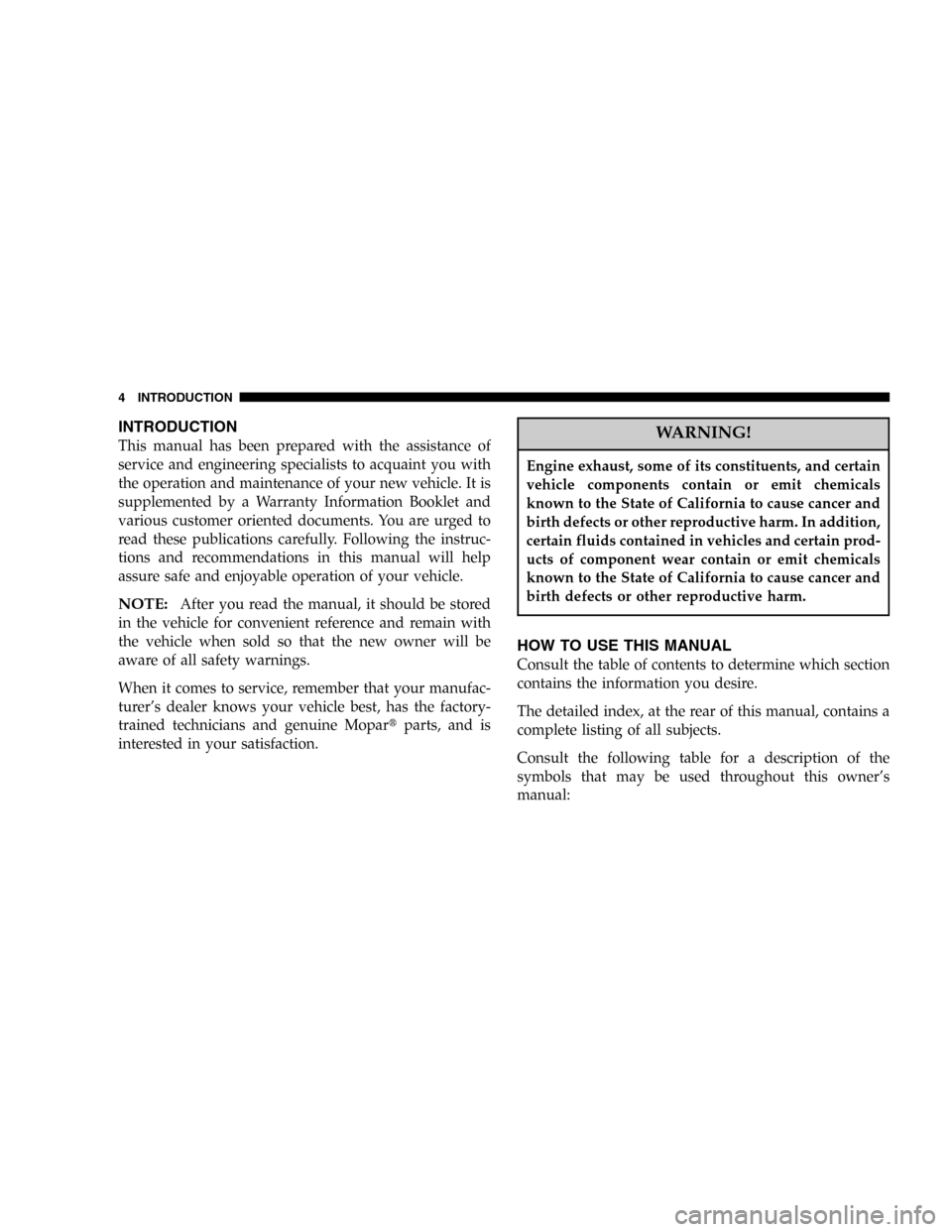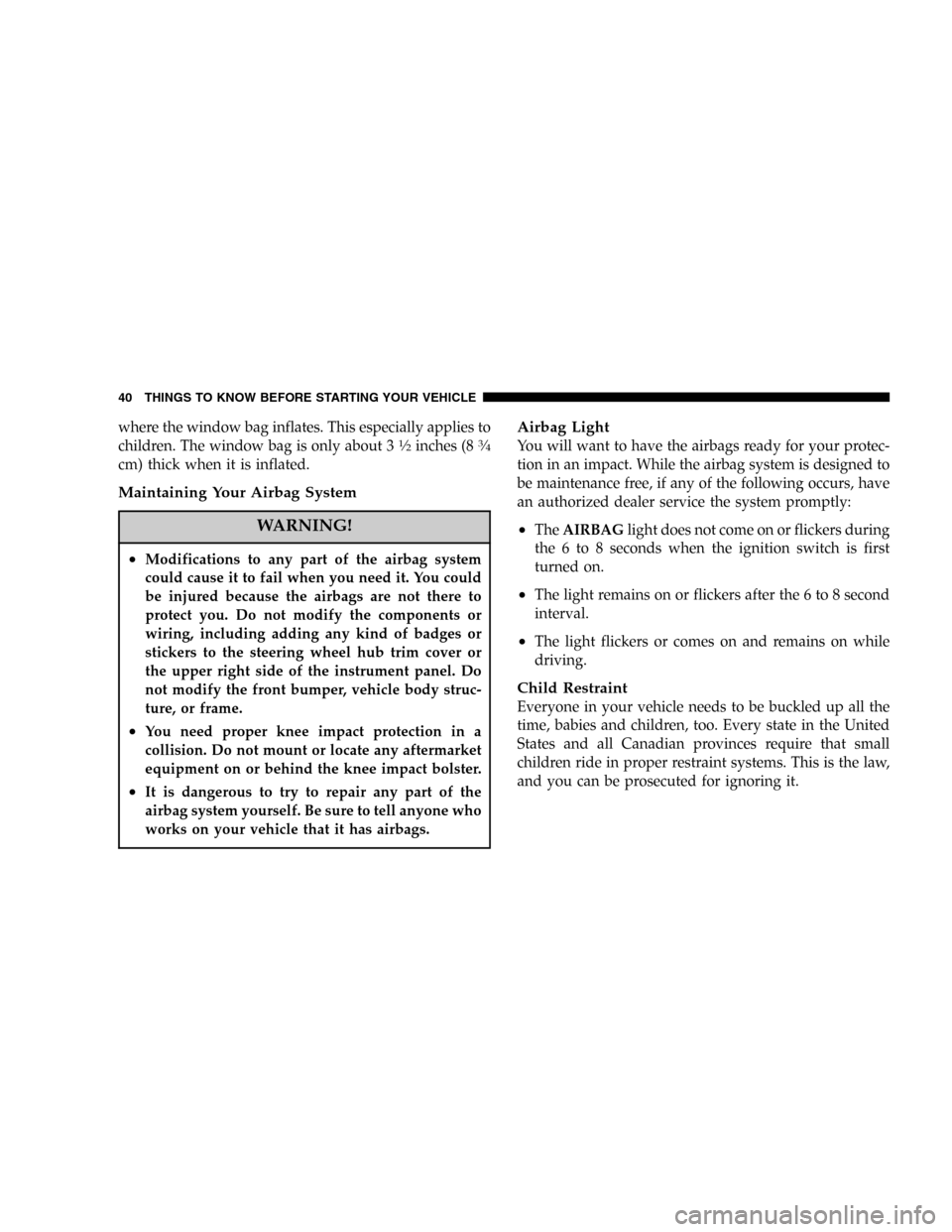Page 1 of 291
TABLE OF CONTENTSSECTIONPAGE
1
INTRODUCTION.............................................................3
2
THINGS TO KNOW BEFORE STARTING YOUR VEHICLE...........................9
3
UNDERSTANDING THE FEATURES OF YOUR VEHICLE............................51
4
UNDERSTANDING YOUR INSTRUMENT PANEL..................................83
5
STARTING AND OPERATING................................................141
6
WHAT TO DO IN EMERGENCIES.............................................185
7
MAINTAINING YOUR VEHICLE..............................................199
8
MAINTENANCE SCHEDULES................................................245
9
IF YOU NEED CONSUMER ASSISTANCE.......................................267
10
INDEX...................................................................277
1
2
3
4
5
6
7
8
9
10
Page 4 of 291

INTRODUCTION
This manual has been prepared with the assistance of
service and engineering specialists to acquaint you with
the operation and maintenance of your new vehicle. It is
supplemented by a Warranty Information Booklet and
various customer oriented documents. You are urged to
read these publications carefully. Following the instruc-
tions and recommendations in this manual will help
assure safe and enjoyable operation of your vehicle.
NOTE:After you read the manual, it should be stored
in the vehicle for convenient reference and remain with
the vehicle when sold so that the new owner will be
aware of all safety warnings.
When it comes to service, remember that your manufac-
turer’s dealer knows your vehicle best, has the factory-
trained technicians and genuine Mopar�parts, and is
interested in your satisfaction.
WARNING!
Engine exhaust, some of its constituents, and certain
vehicle components contain or emit chemicals
known to the State of California to cause cancer and
birth defects or other reproductive harm. In addition,
certain fluids contained in vehicles and certain prod-
ucts of component wear contain or emit chemicals
known to the State of California to cause cancer and
birth defects or other reproductive harm.
HOW TO USE THIS MANUAL
Consult the table of contents to determine which section
contains the information you desire.
The detailed index, at the rear of this manual, contains a
complete listing of all subjects.
Consult the following table for a description of the
symbols that may be used throughout this owner’s
manual:
4 INTRODUCTION
Page 7 of 291
Partial Zero Emission Vehicle (PZEV) for 2.4L — If
Equipped
NOTE:
If the 8th digit of the vehicle identification
number (VIN) contains a�J�then your vehicle is
equipped with the Partial Zero Emissions Vehicle (PZEV)
package.
NOTE:There are specific instructions regarding when
to change the ignition cables and spark plugs with the
PZEV package. Please refer to the Maintenance Sched-
ules section in your owner’s manual for specific mainte-
nance instructions.
VEHICLE MODIFICATIONS / ALTERATIONS
WARNING!
Any modifications or alterations to this vehicle
could seriously affect its roadworthiness and safety
and may lead to an accident resulting in serious
injury or death.
INTRODUCTION 7
1
Page 40 of 291

where the window bag inflates. This especially applies to
children. The window bag is only about 31⁄2inches (83⁄4
cm) thick when it is inflated.
Maintaining Your Airbag System
WARNING!
•Modifications to any part of the airbag system
could cause it to fail when you need it. You could
be injured because the airbags are not there to
protect you. Do not modify the components or
wiring, including adding any kind of badges or
stickers to the steering wheel hub trim cover or
the upper right side of the instrument panel. Do
not modify the front bumper, vehicle body struc-
ture, or frame.
•You need proper knee impact protection in a
collision. Do not mount or locate any aftermarket
equipment on or behind the knee impact bolster.
•It is dangerous to try to repair any part of the
airbag system yourself. Be sure to tell anyone who
works on your vehicle that it has airbags.
Airbag Light
You will want to have the airbags ready for your protec-
tion in an impact. While the airbag system is designed to
be maintenance free, if any of the following occurs, have
an authorized dealer service the system promptly:
•TheAIRBAGlight does not come on or flickers during
the 6 to 8 seconds when the ignition switch is first
turned on.
•The light remains on or flickers after the 6 to 8 second
interval.
•The light flickers or comes on and remains on while
driving.
Child Restraint
Everyone in your vehicle needs to be buckled up all the
time, babies and children, too. Every state in the United
States and all Canadian provinces require that small
children ride in proper restraint systems. This is the law,
and you can be prosecuted for ignoring it.
40 THINGS TO KNOW BEFORE STARTING YOUR VEHICLE
Page 53 of 291
�Power Sunroof—If Equipped.............79
▫Opening Sunroof - Manual...............80
▫Opening Sunroof - Express...............80
▫Closing Sunroof - Manual................80
▫Venting Sunroof - Express................80▫Sunshade Operation....................81
▫Wind Buffeting........................81
▫Sunroof Maintenance....................81
▫Sunroof Fully Closed....................81
�Electrical Power Outlet...................81
UNDERSTANDING THE FEATURES OF YOUR VEHICLE 53
3
Page 81 of 291

Sunshade Operation
The sunshade can be opened manually. However, the
sunshade will open automatically as the sunroof opens.
NOTE:The sunshade cannot be closed if the sunroof is
open.
Wind Buffeting
Wind buffeting can be described as the perception of
pressure on the ears or a helicopter type sound in the
ears. Your vehicle may exhibit wind buffeting with the
windows down, or the sunroof (if so equipped) in certain
open or partially open positions. This is a normal occur-
rence and can be minimized. If the buffeting occurs with
the rear windows open, open the front and rear windows
together to minimize the buffeting. If the buffeting occurs
with the sunroof open, adjust the sunroof opening to
minimize the buffeting.
Sunroof Maintenance
Use only a non abrasive cleaner and a soft cloth to clean
the glass panel.
Sunroof Fully Closed
Press and hold the switch forward until the sunroof stops
completely to ensure that the sunroof is fully closed.
ELECTRICAL POWER OUTLET
The power outlet is located in the lower center of your
instrument panel. If your vehicle is equipped with heated
seats, a second power outlet is located inside the center
console. All accessories connected to any outlet should be
removed or turned off when the vehicle is not in use.
UNDERSTANDING THE FEATURES OF YOUR VEHICLE 81
3
Page 86 of 291
�Remote Sound System Controls—
If Equipped
..........................122
▫Radio Operation......................123
▫Tape Player.........................123
▫CD Player—Single Disc In Radio.........124
▫CD Player—6 Disc CD Changer..........124
�Cassette Tape And Player Maintenance......124
�Compact Disc Maintenance...............125
�Radio Operation And Cellular Phones.......126
�Climate Controls......................126
▫Automatic Temperature Control (ATC)—If
Equipped...........................126
▫Manual Air Conditioning/Heater Control—If
Equipped...........................133
86 UNDERSTANDING YOUR INSTRUMENT PANEL
Page 91 of 291

5. Tachometer
The red area of the scale shows the maximum permissible
engine revolutions-per-minute (rpm x 1000) for each gear
range. Before reaching the red area (over 6,500 rpm), ease
up on the accelerator to prevent engine over speed.
6. Turn Signal Indicators
The arrows will flash in unison with the exterior turn
signal, when using the turn signal lever.
7. High Beam Indicator
This light shows that the headlights are on high
beam. Pull the turn signal lever toward the
steering wheel to switch the headlights from high or
low beam.
8. Speedometer
Shows the vehicle speed in miles-per-hour and
kilometers-per-hour.
9. Charging System Light
This light shows the status of the electrical
charging system. The light should come on
briefly when the ignition is first turned on and remain
on briefly as a bulb check. If the light stays on orcomes on while driving, turn off some of the vehicle’s
electrical devices, such as the Fog Lights or Rear
Defroster. If the Charging System Light remains on, it
means that the vehicle is experiencing a problem with
the charging system. Obtain SERVICE IMMEDI-
ATELY. See your local authorized dealer.
10. Malfunction Indicator Light
This light is part of an onboard diagnostic
system called OBD that monitors engine and
automatic transmission control systems. The
light will illuminate as long as the key is in the ON
position, prior to engine start up. Approximately 15
seconds later the MIL may blink for 10 seconds then
resume to full illumination. (See“EMISSIONS IN-
SPECTION AND MAINTENANCE PROGRAMS”in
the“MAINTAINING YOUR VEHICLE”section of
your Owner Manual for more details). If the bulb does
not come on when turning the key from OFF to ON,
have the condition checked promptly.
Certain conditions such as a loose or missing gas cap or
poor fuel quality may illuminate the light after engine
start. The vehicle should be serviced if the light stays on
UNDERSTANDING YOUR INSTRUMENT PANEL 91
4